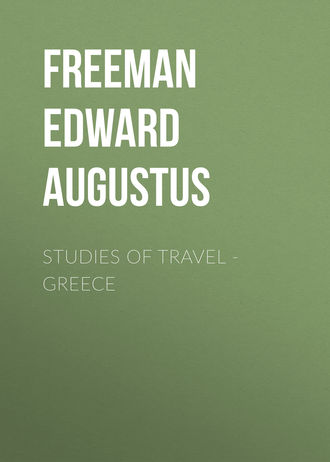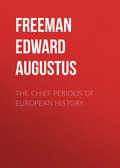
Freeman Edward Augustus
Studies of Travel - Greece
Athens Below the Akropolis
The main characteristic of modern Athens, and one of its chief points of contrast with Rome, is that whatever is not very old is so very new. But the visitor is apt at once to press this characteristic further than strict truth warrants, and to draw a more strongly marked geographical limit between old and new than strict truth warrants either. At first sight we are apt to fancy that everything that is old stands above, and that everything that is new lies below. The fact that the greatest work of all, the temple of Olympian Zeus, happens to lie below, hardly makes a practical exception. By the loss of so many of its columns it has ceased to be in appearance the greatest work of all, and, what is more to the point, it has practically ceased to be part of the city. It lies outside and alone, apart both from the Akropolis and the modern city. It joins indeed to make one of the best and most familiar views of the Akropolis, but it joins only as a foreground to a distant object. To take Mr. Mahaffy’s illustration, it has come to stand to the Akropolis as Hoar Abbey stands to the Rock of Cashel. On another side, the Thêseion, in its absolute perfection as it is seen in any general view, stands as a kind of intermediate link between the upper and the lower region. Otherwise the impression given by the general view of Athens is that the old things are all above, as, with one or two exceptions which need not be dwelled on, the new things undoubtedly are below. The Akropolis seems to throw out the hill of the Mouseion with the monument of Philopappos as a kind of outwork; and, if we take in objects which cannot be seen at the first glance, the most remarkable and venerable objects, the remains of the ancient walls, the tombs cut in the rock, the seats of the Pnyx, the steps on the hill of Arês, all lie on the upper ground. Against these, setting aside very recent diggings, the low city seems to have nothing to set, except a mass of modern and ugly houses and one modern house bigger and uglier than the rest.
This impression is not untrue as regards the general aspect of the city, but it breaks down when we come to examine things somewhat more in detail. There is more of antiquity in the modern city of Athens than one thinks at first sight; still the comparative rarity of ancient remains, and the strong contrast between such as there are and the modern buildings, form a distinct feature in the character of Athens, as distinguished from cities which present to us an unbroken series of monuments from the earlier times to the latest. Again, it is true that, of such ancient remains as there are, the greater part seem, as it were, to shelter themselves under the shadow of the Akropolis, and but few of them belong to the most brilliant times of Athenian history. The Thêseion, standing as a link between the upper and the lower city, has a position of its own. The most perfect of existing Greek temples, it might alone make the fortune of Athens as a place of artistic pilgrimage, even were there nothing else there to see. In the general view it seems to be absolutely perfect. The one small change which it has undergone reminds us at once of a living page of history and of the folly of those who labour in vain to wipe out history. The temple, like its greater fellow on the Akropolis, became a church, but in its new character it still kept a certain appropriate remembrance of its older use. As the house of the Virgin still remained the house of the Virgin, so the house of the warrior hero remained, as the church of St. George, the house of a warrior saint. If, as some say, the older dedication was really not to Thêseus but to Hêraklês, the parallel is in no way weakened, but rather strengthened. Thêseus indeed overthrew the Marathonian bull; but Hêraklês and St. George were alike victorious over dragons. To fit the building for its new use, no change seems to have been needed, beyond taking down two columns of the inner range of the eastern front to make room for the apse of the converted basilica. The caprice of a generation back took away the apse without restoring the columns, and so left the building in a state which would seem incomplete in the eyes of either its heathen or its Christian patrons. Thêseus might ask for his columns; George might ask for his apse; and the common robber of both would be hard put to for an answer. Now, as one of the many detached museums of Athens, the Thêseion contains a collection of sculptures, inscriptions, and architectural fragments, pre-eminent among which is the archaic statue wrought by Aristiôn, which looks so unpleasantly like a specimen of barbaric art. Still, why may we not hold that in sculpture, as in so many other things, likeness does not prove direct connexion, but merely analogy of stage? At all events, Assyria never made anything better than the work of Aristiôn, while Athens went on and grew from the stage of Aristiôn into the stage of Pheidias.
Before the diggings in the Kerameikos which have brought to light such choice sculptures, as well as a large part of the city wall and the Dipylon gate, the Thêseion stood almost alone as a representative of the great days of Athens on ground lower than the Akropolis and the hills which front it. The theatre of Dionysos and the other buildings which have been dug out from the side of the hill are rather part of the Akropolis itself. The temple of Olympian Zeus, and its feeble companion, the Arch of Hadrian, stand apart and make a feeble company by themselves. In that part, however, of the modern city which lies nearest under the Akropolis, we still have a collection of remains of later Greek and Roman times, while such of the Byzantine churches as are left scattered here and there through the city form a study of surprising interest in their own class. All the world knows the monument of Lysikratês and the later hôrologion of Andronikos Kyrrhestês, better known as the Temple of the Eight Winds. Perhaps all the world does not know the singular way in which they were adapted to the uses of rival creeds, how Franciscan friars found a home under the graceful Corinthian finial of Lysikratês, while howling dervishes quartered themselves under the pagan symbols of Andronikos. We mourn as we look at the graceful toy of Lysikratês, the parent of a whole class of structures at St. Remi and Igel — is it sacrilege to add Northampton, Geddington, and Waltham? Genuine Greek Corinthian capitals are so rare that it is sad to see that not one is altogether perfect.
The hôrologion of Andronikos — if it is lawful to speak so freely of anything built at Athens before the Christian era — has never struck us as anything specially graceful, but it is one of the links which directly connect the ancient and the modern city. It stands at what we may call the ancient end of one of the great modern streets, one which seems to represent an ancient street and which from this monument bears the name of Aiolos. But the quarter where the hôrologion stands is one of the quarters where these later and lesser antiquities stand thickest on the ground. Not far off is the Stoa of Hadrian, where the Imperial architect, forsaking the fashion of his own day, tries, like our modern architects, to call up the forms of a past time, and reproduces the ancient Doric, of course in its slenderer form. But this whole quarter is full of remains of one kind and another. The bazaar is in every sense a link to past times; an ancient wall fences it in, and the sight within, so unlike the European streets of the more polished quarters, reminds us that Athens once was an Eastern city. Various scraps lie around us; here are two little forsaken churches side by side forming in a manner one building; the cupola of one is half broken down, and its bell-gable, its κωδωνοστάσιον, is perched on a neighbouring colonnade. Not far off are two buildings, works of intrusive powers and intrusive architecture, both of which form part of the history of the city, and of which the one ought to be preserved as carefully as the other. No one is likely to propose to destroy the colonnade of Roman Corinthian work because its capitals are not of the same types as the capitals of Lysikratês. But it is equally needful to keep the one mosque which remains from Turkish Athens, a building whose style stands to that of the Byzantine churches in somewhat the same relation in which the Roman colonnades stand to the true Grecian. The mosque stands applied to some military purpose. A worthier use for it, a better badge of triumph and deliverance, would have been to make it a memorial church for some of the heroes of the War of Independence. In the same quarter, drawing near to the Thêseion, are the remains of the gymnasion of Ptolemy, where a crowd of inscriptions of various dates tempt us to spell them out, till we light on one which contains the name of the wife of Hêrôdês of Marathôn. His theatre is on the other side of the Akropolis, forming part, like the elder theatre, of the Akropolis itself. But it is in the quarter to the north of the Akropolis, the quarter of the new agorê, in which the visitor to Athens finds more than elsewhere the opportunity for the process so delightful in the old cities of Gaul and Germany, and Italy, the process of prowling hither and thither, and lighting on some fragment of antiquity — the more varied date of style the better — at every quarter. The Akropolis is too carefully cleared of all that is new; the modern city keeps too little that is old; here, in this quarter of Athens, old and new are mingled together in that way which gives to the inquirer the full interest of discovery.
But, among the later antiquities of Athens, it is the churches which claim the highest place. To the traveller from the West they have a special interest. As no other city of his pilgrimage gives him the same store of buildings of pagan Greek architecture, so there is no other which gives him such a store of buildings of the second — the Christian-Greek architecture. Nor is their interest any the less because of the small size of the modern Athenian churches. There is not only nothing to rival St. Sophia, St. Vital, or St. Mark; there is nothing to rival even their own neighbour at Daphnê. The Eastern Church, like the ancient Church of Ireland, seems always to have been better pleased to build a crowd of small churches rather than a single one on the scale of the great minsters of Western Europe. One cause of this peculiarity doubtless was the use of a single altar in the Eastern rite, which suggested the building of several distinct churches in cases where a Western architect would rather have built a single large church with several chapels. Athens, therefore, is full of small churches, the survivors, we fear, of a larger number, some of which perished in the laying out of the modern city. A crowd of them cling, as it were, to the roots of the Akropolis, in the region of the bazaar and of the monument of Andronikos. The eye soon gets used to, but it does not get tired of, their little cupolas and apses, which always add a pleasing feature to the corners where they are found, though none of them rival either the stateliness or the picturesque effect of the churches of the West. A few are of greater size and of higher architectural character, and one, without being of greater size, is one of the greatest curiosities in Christendom. This is the metropolitan church of Athens, surely the smallest church out of Scotia— we seek for a word which shall take in both Cashel and St. Andrew’s — that ever was designed for metropolitan or cathedral rank. It looks like a toy; it has been wittily said that it seems meant to receive the throne of the Boy Bishop. But it has the thorough Byzantine air; it has the apse, the cupola of the Athenian form, the heads of the windows cutting into the cupola — a form which stands to such cupolas as we have seen at Corfu and Daphnê in the same relation in which a German apse or tower with many gabled sides stands to an apse or tower of the more usual form. The church, small as it is, is rich, covered with plates of sculpture, some of which at least are ancient fragments used up again.
It is not easy, at all events for the traveller to whom Byzantine forms are still new, to fix the exact date of the Athenian churches. Nor can he find, at least off-hand, much to help him in easily accessible books. Messrs. Texier and Pullan have put out a splendid book, most valuable for the illustrations of the particular buildings which they think good to describe, but which is useless as a general view of Byzantine architecture, and which does not contain a single Athenian or other Greek example. Mr. J. M. Neale, in his History of the Holy Eastern Church, goes far more fully into the matter, though we are sometimes tempted to kick at the guidance of a writer who talks about “Arta in Ambracia,” and who attributes “a long and peaceful reign” to the Slayer of the Bulgarians. Of the periods into which he divides Byzantine art he places the metropolitan Church in the second, which reaches from 537 to 1003. This takes in the time of Eirênê, the Athenian Empress to whom Athenian tradition is fond of attributing the churches of her native city. But most of the Athenian churches, including the two which call for most special notice, he assigns to his third period, 1003–1453. This period, we do not exactly know why, is said to be one of Latin influence; but why should Latin influence come in in 1003 of all years? and what Latin influence is there to be seen in such buildings as the churches of St. Theodore and the Kapnikarea? These are, on the whole, the two most striking churches in Athens. They stand well in open places of the modern city, a relief, though a strange contrast, among its modern forms — a contrast indeed so strong that we have heard it whispered that their destruction has sometimes been dreamed of. If there is any Latin element in either, it is in the church of the Kapnikarea which has a kind of secondary church, with a cupola of its own, alongside of the main building, with its Greek cross and central cupola. This secondary church does not appear at St. Theodore, but the Kapnikarea has another feature which St. Theodore has not, in the form of a large narthex, which is surely a special sign of orthodoxy. The remembrance of Peterborough flashed across our mind as we saw this noble portico with its six arches, two wider and four narrower, crowned by four gables. It has suffered much in its effect from the glazing of some of the arches, as well as from the rising of the ground, which has covered the columns up to nearly half their height. This portico is indeed worthy of study; it is a legitimate translation into the language of an arched style of the old portico with its entablature, as the west front of Peterborough is a further translation into the language of a style, not only arched, but pointed. Joining on to the narthex is also a porch on the north side, a porch clearly forming part of the same design, with arches resting on columns, and finished with three gabled faces. Instead of these features, St. Theodore has a simple west front, composed, like ordinary west fronts, of doors and windows. Its most marked external feature is the large bell-gable perched on the south transept. Within, the Kapnikarea has the advantage, as its cupola rests on columns with quasi-Corinthian capitals. Those of the portico have capitals of various forms, mostly unclassical. The material of both these churches is mainly that later form of the alternation of stone and brick which grew out of the earlier Roman masonry, and which we have already seen in Corfu.These churches, and a crowd of others, smaller and less striking, will not be passed unheeded by any one in whose eyes history, whether political or artistic, is one unbroken tale. They are, unless we may claim a place for their corrupt follower in the Turkish mosque, the latest among the antiquities of Athens, and they are not less worthy of study than the earliest. With them we will take our leave of the city of the violet crown, and of the land of which the wisdom of some præ-historic reformer made her more than the head. We pass from Athens and from Attica; one stage more, one bound rather, over the central sea of Greece, will lead us beyond the bounds of Hellas itself. One thought more comes across us as we pass from Athens, as we make ready to pass from Greece. Between the work of the earliest and of the latest Grecian heroes there is a strange likeness. Thêseus — that name will do as well as any other — brought together rival cities to form one abiding commonwealth, and thereby to create the Athens alike of archons, emperors, dukes, and kings. As rival cities forgot their rivalry in the presence of Thêseus, so rival party leaders forget their rivalries in the presence of Kanarês. The hero is gone; and while we write this, Greece, and those who care for Greece, are wondering who can fill his place. His place in truth no one can fill, but the lesson taught by the close of his life ought not to pass away. If rival leaders could work side by side at the bidding of the one man whom all were proud to own as their master, they may go on in the same unselfish path when the voice which calls them to union is no longer the voice of one man, however illustrious, but the voice of their country itself.
Marathôn
The visitor to Athens, even if he has not time to examine every historic spot in Attica, must at least visit the most historic spot of all, the spot where it was fixed that Attica should remain Attica and that Europe should remain Europe. Mr. Lowe, we may well believe, stood alone in looking on the fight of Marathôn as a matter of small importance, because the day which fixed the destiny of the world saw only a comparatively small amount of slaughter. Mr. Lowe of course really knew better; but there are those who really seem not to know better, those who measure things only by their physical bigness, and cannot take in either their results or their moral greatness. There has often been far more blood shed to decide which of two Eastern despots should have the mastery than was shed to decide that Europe should not fall under the dominion of Eastern despots. Never surely did the future fate of the world hang in the same way on the will of a single man as when the arguments of Miltiadês won over the Polemarch Kallimachos to give his vote for immediate battle. That vote was, as it were, the very climax of European constitutional life. All rested on the voice of one man, not because all authority was vested in one man, but because it was vested in many. When the ten generals were equally divided, Kallimachos gave the casting vote, and Europe remained Europe. It is inconceivable that, if Athenian freedom had been then crushed when it was still in its first childhood, the course of the world’s history could have been what it has been. Enslaved Greece could never have been what free Greece was. Athens and Megalopolis could have been no more than an Ephesos or Milêtos. It may well be that, even if the Eastern peninsula had been rent away from the Western world, the central peninsula might still have stood its ground. The barbarian might still have been checked, and checked for ever, by the hands of Romans or Samnites or Lucanians. The Roman power might still have been spread over the world; the Teuton and the Slave might still have come to discharge their later mission within the Roman world; but a Roman world, untutored by Greece, could never have been what the Roman world of actual history was and is. The men who fought at Marathôn fought as the champions of every later generation of European man. If on the Akropolis of Mykênê we feel that we have some small share, the share of distant kinsmen, in the cradle of the oldest European civilisation, the subject of the oldest European literature — so, as we stand on the barrow of the one hundred and ninety-two who died at Marathôn, we feel that we have a nearer claim, the claim of men who come on pilgrimage to the resting-place of men who died that European lands and European men should be all that they have been.
In fact, on the plain of Marathôn, the famous saying of Johnson becomes clothed with a fuller meaning than its author is likely to have thought of. “That man is little to be envied whose patriotism would not gain force upon the plain of Marathôn.” The saying is true, if we think merely of association, of example, of analogy. It becomes true in a yet higher sense, if we look on the day of Marathôn as being all that it truly is, as having fixed, not only the destiny of Athens, but the destiny of Europe. And we may look on that spot from another point of view, less wide indeed than this, but wider than that which looks on it simply as the scene of a single event of the year 490 before our era. Even setting aside the event which has made Marathôn famous with an undying fame, Marathôn would still have a considerable history, mythical and real — a history some chapters of which come within the memory of many of us. We must remember that, besides the view which looks on Greece as being almost in her first youth on the day of Marathôn, there is another view which looks on Greece as being then already in her decline. The one view is true, if we think only of Athenian democracy, of Athenian art, of Athenian poetry; the other view is no less true in the general history of the Greek nation. When the fight of Marathôn was fought, the bondage of the Greek nation had already begun; the work which was ended by Mahomet the Conqueror had been already begun by Crœsus and Cyrus. Asiatic Greece was already enslaved; the fight of Marathôn was fought in order that European Greece might not be enslaved like it. It may also flash across the minds of some who tread the plain of Marathôn that the fight which Miltiadês waged there in the cause of Hellenic freedom was not the last fight which has been waged on the same ground in the same cause. On that same plain, where the Athenians of one age fought to save Greece from coming under the yoke of the Persian, the Athenians of another age fought to free enslaved Greece from the yoke of the Turk. The modern fight of Marathôn, the fight of July, 1824, hardly ranks among the great events of the War of Independence, as its leader certainly does not rank among the purest heroes of the War of Independence. Yet when Gouras smote the janissaries of Omar of Karystos on the same ground on which Miltiadês had smitten the hosts of Datis and Artaphernês, to an eye which takes in the whole range of Grecian and European history, the fact has something more about it than mere association, than mere coincidence. The two fights of Marathôn were in truth only two stages in one long tale, the tale of the undying struggle between civilisation and the freedom of the West and the barbarian despotism of the Eastern world.
Marathôn, like Eleusis, gives us the usual lesson in Greek geography, and makes us better understand the greatness of that wonderful change which fused all the towns of Attica into a single commonwealth. We see at once that Marathôn — the name was, at least in later use, extended to the whole Tetrapolis — was, no less than Eleusis, designed, according to the common laws of Greek political geography, to form a separate state, distinct from Athens. Indeed it is more thoroughly cut off than Eleusis. In the view from the Akropolis, Pentelikos altogether hides the Marathônian plain; while, though Eleusis is actually kept out of sight by Aigaleôs, Kithairôn and the other greater heights beyond it suggest the existence of the Thriasian plain. Marathôn therefore, naturally enough, has a long mythical history distinct from that of Athens. Not only Thêseus, but Hêraklês and the Hêrakleidai figure in it, and legend tells of a fight of Marathôn earlier than either of those which history records. Hêraklês remained in historical times the chief object of local worship, and it was by his sanctuary that the Athenian host encamped before, what we suppose we must call, the second battle. Athênê too, as on other spots of Attic soil, was not without her temple by the marsh. Marathôn does not appear in the Catalogue any more than Eleusis, and for the same reason as Eleusis. But its name appears in the Odyssey in a passage which may suggest some geographical reflections:
Ὤς ἄρα Φωνήσασ’ ἀπέβη γλαυκῶπις Ἀθήνη
Πὸντον ἐπ’ ἀτρύγετον· λίπε δὲ Σχερίην ἐρατεινήν·
Ἴκετο δ’ ἐς Μαραθῶνα καὶ εὐρυάἈγυιαν Ἀθήνην,
Δῦνε δ’ Ἐρεχθῆος πυκινὸν δόμον·
If Scheriê really be Corfu, this may seem a most unexpected route to Athens, and yet it is hardly more wonderful than the route by Syra by which the modern traveller often actually goes. In history the first appearance of Marathôn is when Peisistratos lands there on his return from exile. The second is when the son of Peisistratos led the Persian host thither, as a fitting place for the use of the cavalry which after all they seemed not to have used. No battle in history has been more minutely examined, and that in some cases by men who united technical military knowledge with a thorough knowledge of the country. Colonel Leake, to mention only one inquirer, has done all that the union of both qualities could do, though one is amazed at his constantly referring to Herodotus as a contemporary writer. Yet, after all his labours, after all the labours of Mr. Finlay and others, everybody complains that the narrative of Herodotus is unsatisfactory. The comments of Dean Blakesley strike us as among the most acute that have been made. One may doubt whether Herodotus had ever been there; he certainly shows no knowledge of the ground. He makes no mention of the marshes which form so marked a feature in the character of the Marathônian plain. The marshes lie between the sea and the fighting-ground, as the fighting-ground lies between the marsh and the mountains. The marsh is not only not mentioned by Herodotus, but his account seems almost inconsistent with its existence. But Pausanias saw the picture in the Poikilê which showed the Persians falling into the marsh. It is like appealing to the Bayeux Tapestry from the later accounts of the battle of Senlac. Pausanias, though he lived so many ages after, was in this way really nearer to the time than Herodotus. The picture commemorated the fact; Herodotus tells the story as it had grown up a generation later. By that time, as Dean Blakesley says, the story had come under the operation of the law by which “popular tradition rapidly drops all those particulars of a battle which evince strategic genius, and substitutes for them exaggerated accounts of personal bravery.” Miltiadês, as a good general, took advantage of the ground, and largely owed his success to the nature of the ground. Popular tradition made everything be done by sheer hard fighting.
In short, almost every detail of this memorable fight seems shrouded in uncertainty. It is hard to fix the exact position of either army, and the very name of Marathôn has perhaps shifted its place. The site of the old town seems quite as likely to be, not at the modern Marathôn, but, as Colonel Leake puts it, at Brana. Yet, amid all this doubt, there is essential certainty. Of the work that was done that day, of the general site, there is no doubt, and the most living and speaking monument of all is there to bear its witness. We stand, not, as the poet puts it, on the Persians’ grave, but on the mound which covers the ashes of the men of Athens who fell that day. Within the space between the bay with its blue waters and the hills which fence in the plain, the fate of Europe was fixed. We stand on the mound; the eye passes over the hills, from Probalinthos to the cape of Kynosoura. We look on the older and the newer candidate of the name of Marathôn; we look on the hill where older legends fixed the home of Pan, and where the later name of Drakonera speaks of some older or later dragon myth. We know that it was within these bounds that the might of Asia was broken by the force of two Hellenic cities. Standing on that mound, instead of dreaming, as the poet dreamed in the days of enslaved Greece, we may call to mind how, in the cycle of human things, another triumph of Europe over Asia was won on the same spot, and if there be, as other poets tell us, two special voices which call to freedom, no spot could be better chosen for the work that was done there than the Marathônian plain. Once that land was said to be
Unchanged in all except its foreign lord.
Now the foreign lord is gone, and for the rest no change is needed. The mountains are there, the sea is there, and, almost as imperishable as themselves, the mound of the fallen heroes is there also. At no great distance from the mound, some stones remain which are held to mark the separate monument of the leader of that day’s battle. Standing there, by the grave of Miltiadês, we think of that day only. On the plain of Marathôn, we will not think either of Paros or of Chersonêsos.
While we write, perhaps no inopportune moment, the news comes that Greece has lost the last and the noblest of her later heroes. The man of other times in whom all his countrymen trusted — the man before whom the chiefs of contending parties could lay their jealousies aside — is taken away from his country in the moment of her utmost need. One tie which binds us to the past is rudely snapped, when the last of the heroes of the past, the last of the ἡμιθέων γένος ἀνδρῶν, passes away from the work to which his county had again called him. After a life of ninety years and more — a life in which the severest of censors, whose scourge spared neither Greek nor Englishman, could not find a single flaw — the hero of the fire-ships is no more. The name of Constantine Kanarês is added to the same roll of departed worthies as Miaoulês and Botzarês, as Church and Hastings. And in the long list of men who for so many ages have done honour to the Hellenic name, among the chosen few whose glory no speck tarnishes, along with Phormiôn and Kallikratidas, men of his own calling and his own element, the pen of history will engrave no nobler name than the name of him who has just gone, of him who has as truly died in the service of his country as if he had fallen fifty years back, like Kynaigeiros himself by the shore of Marathôn.







